Blending herbal teas for mindful rituals connects you to nature's wisdom and transforms your daily routine. You'll customize flavors and aromas to suit your taste while enhancing mindfulness through intentional preparation. These personalized blends can balance your energy and emotions throughout the day, honoring ancient healing traditions. By embracing slow living practices and deepening meditation, you'll foster a stronger connection with yourself and others. Herbal tea rituals also help align your body with natural circadian rhythms, promoting overall wellness. There's so much more to discover about the art of mindful tea blending and its profound impact on your well-being.
Connecting With Nature's Wisdom

As we explore the world of herbal teas, we're tapping into centuries of natural wisdom. You're not just brewing a beverage; you're connecting with the earth's healing potential. Each herb carries unique properties, carefully honed by nature over millennia. When you blend these herbs, you're creating a personalized remedy that aligns with your body's needs.
You'll discover that different plants offer various benefits. Chamomile soothes anxiety, while peppermint aids digestion. Lavender promotes relaxation, and ginger boosts immunity. By selecting and combining these herbs, you're engaging in an ancient practice of holistic healing.
This connection to nature's wisdom extends beyond physical health. As you brew your tea, you're participating in a ritual that grounds you in the present moment. The act of preparing and sipping your blend becomes a mindful practice, allowing you to pause and reflect.
You're also becoming more attuned to the seasons and your environment. Certain herbs thrive at different times of the year, encouraging you to align your blends with nature's rhythms. This awareness fosters a deeper appreciation for the natural world and your place within it.
Customizing Flavors and Aromas
One of the most rewarding aspects of creating herbal tea blends is the ability to customize flavors and aromas to your liking. You can experiment with different combinations to create a unique taste that resonates with your preferences and supports your mindfulness practice. Start by identifying your favorite flavors and scents, then explore complementary herbs that enhance these qualities.
Consider the following popular herbs and their characteristics when crafting your blend:
| Herb | Flavor | Aroma | Benefits |
|---|---|---|---|
| Chamomile | Floral, sweet | Soothing | Relaxation |
| Peppermint | Cool, invigorating | Invigorating | Digestive aid |
| Lavender | Floral, subtle | Calming | Stress relief |
| Ginger | Spicy, warm | Energizing | Anti-inflammatory |
As you mix and match herbs, pay attention to how they interact with one another. Some combinations may surprise you, creating complex flavors that evolve as you sip. Don't be afraid to adjust ratios or add new elements to achieve the perfect balance. Remember, the goal is to create a blend that not only tastes and smells delightful but also supports your mindfulness practice.
Enhancing Mindfulness Through Preparation
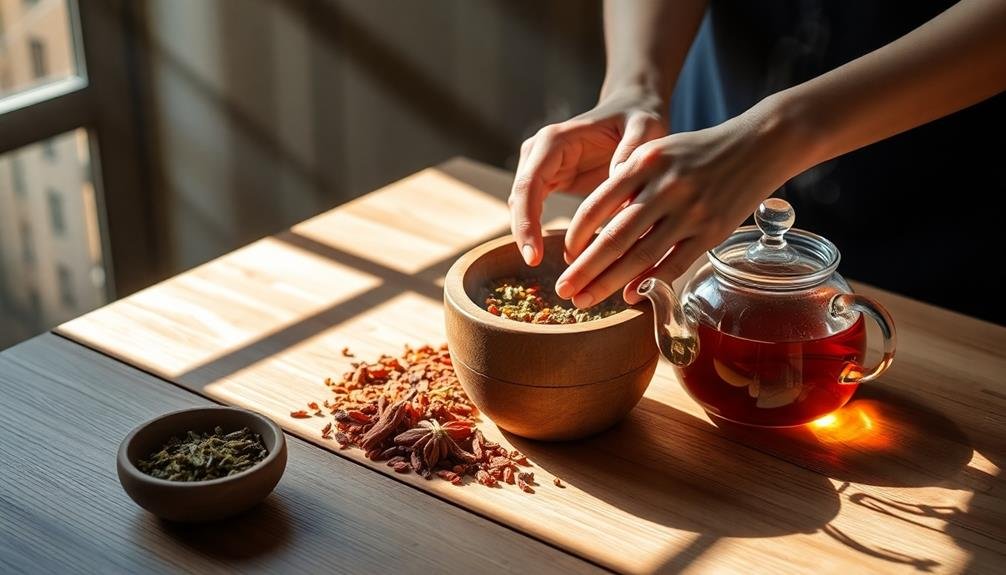
When preparing your herbal tea, you'll enhance mindfulness by focusing on the sensory experience.
You can practice intentional brewing techniques, paying close attention to each step of the process.
Creating a sacred preparation space will further elevate your tea ritual and deepen your mindful connection.
Focusing on Sensory Experience
Preparing herbal tea offers a unique opportunity to engage your senses and enhance mindfulness. As you begin, focus on the visual aspect of the herbs. Notice their colors, shapes, and textures. Observe how they change as you add hot water, releasing their natural oils and essences.
Next, inhale deeply to appreciate the aromatic bouquet. Each herb contributes its distinct scent, creating a complex olfactory experience. Let the steam carry these fragrances to you, allowing them to evoke memories or emotions.
As you sip your tea, pay attention to its temperature and how it feels in your mouth. Notice the flavors that dance across your taste buds. Is it sweet, bitter, or earthy? Can you identify individual herbs? Let the taste linger, savoring each nuance.
Listen to the gentle sounds of pouring water, the clink of your spoon against the cup, and the subtle whisper of steam rising. These auditory cues can ground you in the present moment.
Practicing Intentional Brewing Techniques
To enhance mindfulness through preparation, you'll want to embrace intentional brewing techniques. Start by selecting your herbs mindfully, considering their properties and how they align with your intentions. As you measure and combine the herbs, focus on each action, noting the textures, colors, and aromas.
Heat your water to the appropriate temperature for your blend, observing the bubbles as they form. While the water heats, prepare your brewing vessel, ensuring it's clean and warmed. Pour the water over your herbs slowly, watching as they unfurl and release their essences.
| Herb Type | Steep Time | Water Temperature |
|---|---|---|
| Delicate | 1-3 minutes | 160-180°F (71-82°C) |
| Medium | 3-5 minutes | 180-190°F (82-88°C) |
| Robust | 5-7 minutes | 190-212°F (88-100°C) |
As your tea steeps, practice patience and presence. Notice the changing color and aroma of the infusion. When it's ready, pour mindfully, appreciating the stream of liquid and the rising steam. Before drinking, take a moment to express gratitude for the nourishing brew you've created. This intentional process transforms tea preparation into a meditative ritual, deepening your connection to the present moment.
Creating Sacred Preparation Space
For a truly mindful tea ritual, creating a sacred preparation space is essential. Start by selecting a quiet area in your home where you can focus without distractions. Clear this space of clutter and unnecessary items, leaving only what you need for your tea preparation.
Consider adding elements that appeal to your senses and promote tranquility, such as soft lighting, calming music, or aromatic incense.
Arrange your tea-making tools with intention. Place your teapot, cups, and utensils mindfully, creating a visually pleasing setup that flows naturally. Choose items that hold personal significance or beauty, as they'll enhance your connection to the ritual.
Incorporate natural elements like plants, crystals, or a small water feature to bring a sense of harmony to your space.
As you enter this sacred area, take a moment to ground yourself. Remove your shoes, take a few deep breaths, and set your intention for the tea ritual.
This physical and mental shift helps change your mindset, allowing you to fully engage in the present moment. By creating a dedicated space for your tea preparation, you're setting the stage for a more profound and mindful experience.
Balancing Energy and Emotions
Herbal teas can work wonders for balancing your energy and emotions throughout the day. Different herbs have unique properties that can help you manage stress, boost mood, and regulate energy levels.
For instance, chamomile and lavender are known for their calming effects, perfect for winding down in the evening or during stressful moments. On the other hand, peppermint and ginger can invigorate your senses and provide a natural energy boost without the jitters of caffeine.
When blending teas for emotional balance, consider adaptogens like ashwagandha or holy basil. These herbs help your body adapt to stress and promote overall well-being.
For mood elevation, try St. John's Wort or lemon balm, which can gently lift your spirits. If you're feeling anxious, passionflower or skullcap might offer relief.
To enhance focus and mental clarity, incorporate rosemary or ginkgo biloba into your blends.
Honoring Ancient Healing Traditions
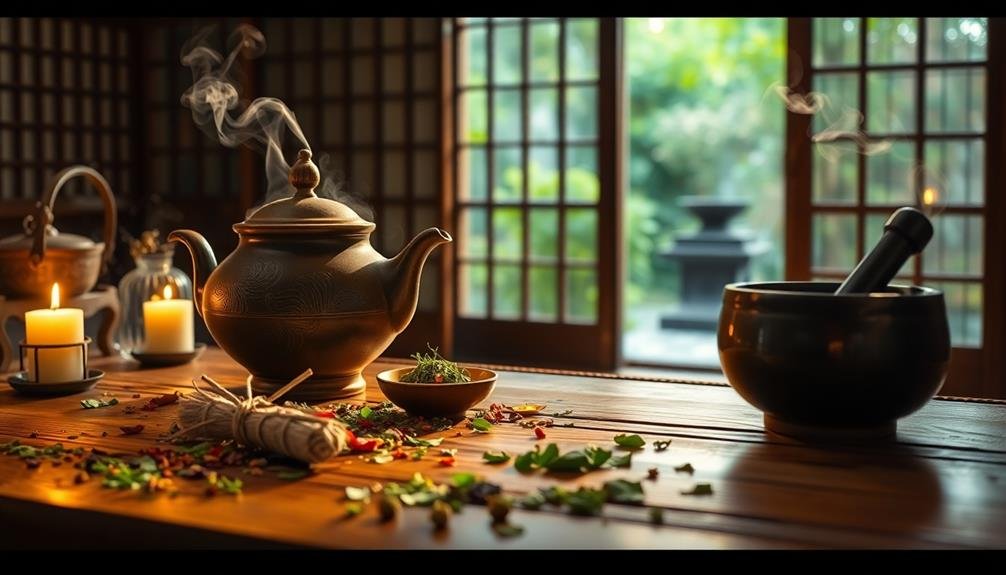
Ancient civilizations' wisdom continues to influence our modern approach to herbal teas and healing rituals. By blending herbs for mindful rituals, you're tapping into centuries-old practices that have stood the test of time. Traditional Chinese Medicine, Ayurveda, and Native American healing methods all emphasize the power of plants in promoting physical and spiritual well-being.
When you create herbal tea blends, you're honoring these ancient traditions and their deep understanding of nature's healing properties. You're acknowledging the interconnectedness of mind, body, and spirit that these cultures recognized long ago. By incorporating specific herbs known for their medicinal qualities, you're embracing a holistic approach to health that goes beyond mere symptom management.
Moreover, you're participating in a ritual that connects you to your ancestors and the earth itself. As you steep your carefully crafted blend, you're engaging in a practice that has brought comfort and healing to countless generations before you.
This connection to the past can provide a sense of grounding and purpose in your modern life, reminding you of the timeless wisdom that nature offers.
Exploring Seasonal Tea Blends
As you embrace the rhythm of nature, you'll find that herbal teas can align with the changing seasons.
Spring renewal blends invigorate your senses, while summer cooling infusions offer revitalizing relief from the heat.
When autumn arrives, you can turn to cozy tea combinations that warm your body and soul.
Spring Renewal Tea Blends
When spring arrives, bringing renewed energy and fresh beginnings, it's the perfect time to explore seasonal tea blends that complement this vibrant time of year.
Spring renewal tea blends often feature light, rejuvenating ingredients that awaken your senses and support your body's natural cleansing processes.
You'll find many spring blends incorporate nettle, known for its detoxifying properties, and dandelion root, which supports liver function. Lighter flavors like lemon balm and mint add a crisp, invigorating note to your cup.
Consider including herbs like chamomile or lavender for a calming effect, balancing the season's energizing qualities.
Floral elements such as rose petals or elderflower can add a delicate sweetness and aroma, evoking the blooming gardens of spring.
Green tea is an excellent base for spring blends, offering a boost of antioxidants and a gentle caffeine lift.
As you craft your spring renewal blend, think about incorporating ingredients that support seasonal allergies, like ginger or turmeric, to help you fully embrace the season's beauty.
Experiment with different combinations to create a personalized blend that resonates with your spring renewal intentions.
Summer Cooling Herbal Infusions
The scorching heat of summer calls for revitalizing herbal infusions that cool and hydrate. As you seek relief from the sun's intensity, turn to invigorating blends that soothe your body and mind. Craft your own summer cooling infusions using a combination of herbs known for their cooling properties and delightful flavors.
Consider these popular herbs for your summer tea blends:
| Herb | Cooling Properties | Flavor Profile |
|---|---|---|
| Peppermint | Cooling, invigorating | Minty, crisp |
| Hibiscus | Tart, invigorating | Floral, tangy |
| Lemongrass | Citrusy, cooling | Light, zesty |
To create your perfect summer infusion, start with a base of peppermint or spearmint leaves. Add hibiscus flowers for a vibrant color and tart flavor, then balance it with lemongrass for a citrusy note. Experiment with other cooling herbs like chamomile, lavender, or rose petals to customize your blend. Steep your herbs in cold water for several hours or overnight for a revitalizing iced tea. You'll find that these cooling infusions not only quench your thirst but also provide a moment of mindfulness during the hectic summer months.
Cozy Autumn Tea Combinations
Warmth and comfort define the essence of autumn tea blends. As the days grow shorter and cooler, you'll find solace in cozy herbal combinations that nourish both body and soul. These seasonal blends often feature earthy, spicy, and sweet notes that evoke the spirit of fall.
When crafting your autumn tea rituals, consider these comforting combinations:
- Cinnamon and apple: A classic pairing that captures the essence of autumn, offering a sweet and spicy profile.
- Ginger and turmeric: A warming blend with anti-inflammatory properties, perfect for boosting immunity.
- Rooibos and vanilla: A caffeine-free option with a rich, creamy flavor that's ideal for evening relaxation.
- Chai spices and pumpkin: A festive mix that combines traditional chai spices with the quintessential fall flavor.
As you sip these autumn blends, you'll notice how they align with the season's energy. They'll help you slow down, reflect, and embrace the introspective nature of fall.
You can enhance your tea ritual by pairing it with journaling, meditation, or simply watching the leaves change color outside your window. By incorporating these seasonal teas into your daily routine, you're creating a mindful practice that connects you to nature's rhythms.
Cultivating Gratitude and Intention
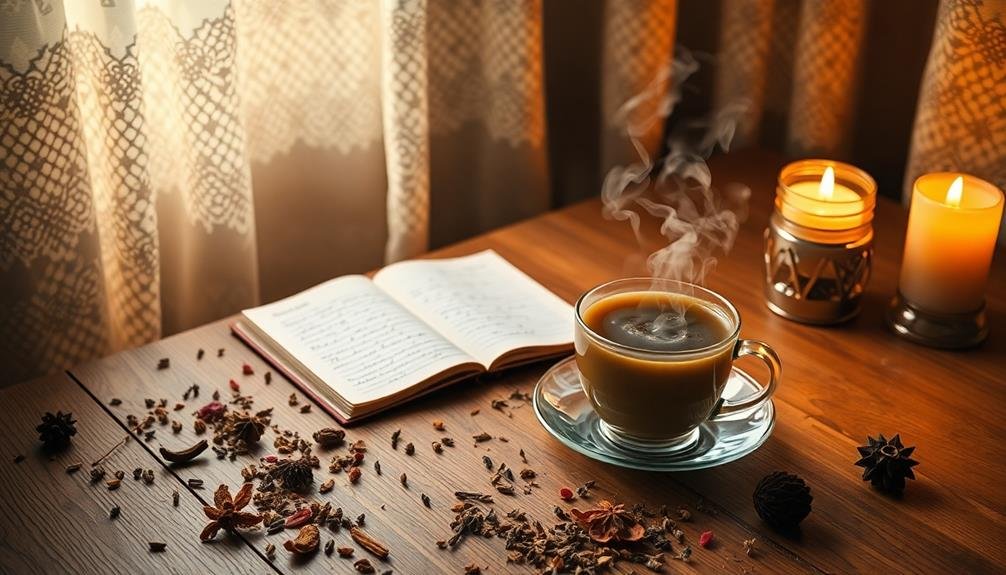
Embracing gratitude and intention elevates your herbal tea ritual from a simple act to a transformative experience. As you prepare your blend, focus on the present moment and reflect on the things you're thankful for.
Consider each herb's unique properties and how they'll contribute to your well-being. Set an intention for your tea ritual. It could be as simple as finding calm in a busy day or as profound as manifesting personal growth.
As you steep the herbs, visualize your intention infusing into the water along with the plant essences. Breathe deeply, inhaling the aromatic steam and allowing it to center your thoughts.
When you sip your tea, do so mindfully. Notice the flavors, temperature, and how it makes you feel. Use this time to reaffirm your intention and express gratitude for the nourishment you're receiving.
Make it a habit to jot down your thoughts or intentions in a journal during this ritual.
Nourishing Body and Soul
You'll find that herbal teas offer more than just pleasant flavors; they're powerful tools for holistic wellness.
As you sip mindfully, you're not only nourishing your body with beneficial compounds but also creating a moment of tranquility for your soul.
These natural brews can help balance your energy and mood, making them perfect companions for your daily rituals.
Holistic Wellness Through Herbs
Beyond their soothing flavors, herbal teas offer a gateway to holistic wellness, nourishing both body and soul. As you incorporate these natural brews into your daily rituals, you're embracing a centuries-old practice of herbal healing.
Each cup becomes a moment of self-care, allowing you to tap into the plant kingdom's wisdom and harness its therapeutic properties.
Herbal teas support your overall well-being by:
- Boosting your immune system with antioxidant-rich herbs like echinacea and elderberry
- Calming your nervous system through adaptogenic herbs such as ashwagandha and holy basil
- Aiding digestion with carminative herbs like peppermint and ginger
- Promoting restful sleep with sedative herbs such as chamomile and valerian root
Mindful Sipping Experiences
Three key elements transform herbal tea sipping into a mindful ritual that nourishes both body and soul.
First, engage your senses fully. As you prepare your tea, inhale its aroma deeply. Notice the colors and textures of the herbs. Listen to the gentle sound of water being poured. Feel the warmth of the cup in your hands. Savor each sip, allowing the flavors to unfold on your palate.
Second, create a sacred space for your ritual. Choose a quiet, comfortable spot where you won't be disturbed. Light a candle, play soft music, or surround yourself with nature. This environment helps you shift into a more peaceful state of mind.
Lastly, set an intention for your tea ritual. Whether it's to relax, energize, or reflect, having a purpose adds depth to the experience. As you sip, focus on your breath and let go of distracting thoughts.
This mindful approach allows you to be fully present in the moment, connecting with yourself and the nourishing qualities of the herbs you've chosen. By incorporating these elements, you'll transform a simple act of drinking tea into a deeply nurturing practice for both body and mind.
Balancing Energy and Mood
Carefully selected for their unique properties, herbal teas can play an essential role in balancing your energy and mood throughout the day. By incorporating specific blends into your routine, you'll find natural ways to uplift, calm, or energize yourself as needed.
Start your morning with invigorating blends like peppermint or ginger to awaken your senses and boost alertness. For mid-day focus, try rosemary or ginkgo biloba teas to enhance mental clarity and concentration. When stress levels rise, reach for calming chamomile or lavender to soothe your nerves and promote relaxation.
End your day with valerian root or passionflower tea to prepare for restful sleep.
Consider these four key benefits of using herbal teas for energy and mood balance:
- Natural caffeine-free alternatives for sustained energy
- Adaptogenic herbs to help manage stress and fatigue
- Mood-enhancing compounds that promote emotional well-being
- Sleep-inducing properties for better rest and recovery
Creating Personal Tea Rituals

Establishing a personal tea ritual can transform your daily routine into a mindful practice. To create your own ritual, start by selecting a specific time each day for your tea ceremony. Choose a quiet space where you won't be disturbed and gather your favorite teaware. Consider using a special teapot, cup, or infuser that holds personal significance.
Next, select your herbal tea blend. You might create a custom mix based on your needs or choose a pre-blended variety. As you prepare your tea, focus on each step: heating the water, measuring the herbs, and steeping. Use this time to practice deep breathing or meditation.
When your tea is ready, take a moment to appreciate its aroma before sipping slowly. Pay attention to the flavors and sensations as you drink. You can use this time for reflection, journaling, or simply enjoying the present moment.
Customize your ritual by incorporating elements that resonate with you, such as lighting a candle, playing soft music, or reciting affirmations.
Consistency is key – make your tea ritual a daily habit to fully experience its mindfulness benefits.
Embracing Slow Living Practices
Your personal tea ritual is just one step towards a more mindful lifestyle. Embracing slow living practices can help you cultivate a deeper sense of presence and appreciation for life's simple pleasures.
By incorporating these practices into your daily routine, you'll find yourself more grounded and connected to the present moment.
Slow living isn't about doing everything at a snail's pace; it's about being intentional with your time and energy. It encourages you to savor experiences, reduce stress, and prioritize what truly matters.
When you embrace slow living, you'll notice a shift in your perspective and overall well-being.
Here are four ways to incorporate slow living practices into your life:
- Practice mindful eating by savoring each bite and avoiding distractions
- Dedicate time for digital detoxes to reconnect with yourself and others
- Engage in purposeful movement, like gentle yoga or nature walks
- Create a morning routine that sets a calm and intentional tone for the day
Deepening Meditation With Tea

Tea and meditation often go hand in hand, creating a powerful synergy for mindfulness and self-reflection. When you incorporate tea into your meditation practice, you're enhancing your ability to focus and remain present. The act of preparing and sipping tea can serve as a prelude to your meditation, helping you shift from a busy mind to a calm state.
Choose teas that complement your meditation goals. Chamomile can promote relaxation, while green tea may boost mental clarity. As you brew your tea, use the process as a mini-meditation, focusing on each step with intention.
During your meditation, keep your tea nearby. The aroma can anchor your attention and deepen your practice. You can also use tea as a focal point for mindfulness exercises. Pay attention to the warmth of the cup in your hands, the steam rising, and the flavors on your tongue. This sensory awareness can help quiet your mind and bring you into the present moment.
After your meditation, sipping tea can help you gradually return to your daily activities while maintaining a sense of calm and centeredness.
Fostering Community Through Sharing
Countless communities have formed around the simple act of sharing tea. When you blend and share herbal teas, you're not just offering a drink; you're inviting others into a ritual of connection and mindfulness. This shared experience can strengthen bonds, foster open communication, and create a sense of belonging.
By crafting your own herbal tea blends, you're able to tailor the experience to your community's needs and preferences. This personalization can lead to deeper conversations and more meaningful interactions. Whether it's a weekly gathering of friends or a larger community event, sharing tea can become a catalyst for building relationships and creating lasting memories.
Here are four ways sharing herbal teas can foster community:
- Creating a safe space for open dialogue
- Encouraging mindfulness and presence in group settings
- Promoting cultural exchange through diverse tea traditions
- Facilitating regular gatherings that strengthen social bonds
As you share your herbal tea blends, you're not just nourishing bodies but also nurturing connections. This simple act can transform ordinary moments into opportunities for growth, understanding, and collective well-being.
Aligning With Circadian Rhythms
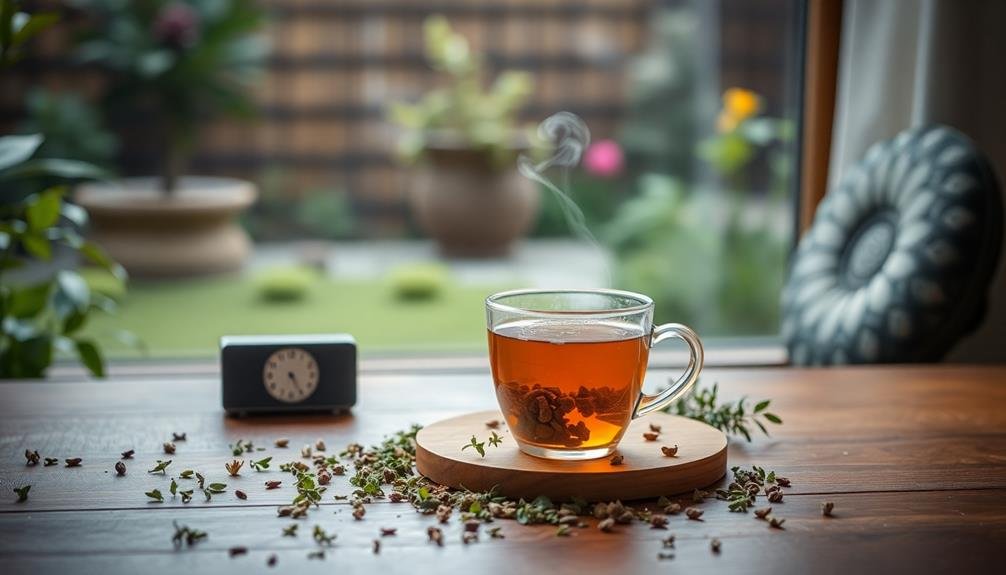
Our bodies operate on an internal clock, synchronized with the natural cycles of day and night. This circadian rhythm influences various physiological processes, including sleep, hormone production, and metabolism.
By aligning your herbal tea consumption with these natural cycles, you'll enhance your overall well-being and mindfulness practices.
In the morning, opt for invigorating blends containing herbs like peppermint, ginger, or lemon balm. These stimulating ingredients will help you wake up and feel energized for the day ahead.
As the afternoon approaches, switch to balancing teas with ingredients such as green tea or holy basil to maintain focus and combat the mid-day slump.
As evening sets in, shift to calming blends featuring chamomile, lavender, or valerian root. These herbs promote relaxation and prepare your body for restful sleep.
By crafting your tea rituals around your body's natural rhythms, you'll create a harmonious flow throughout your day.
Remember to listen to your body's cues and adjust your tea choices accordingly. This mindful approach to herbal tea consumption will help you stay in tune with your circadian rhythms and support your overall health and wellness journey.
Frequently Asked Questions
How Long Can Blended Herbal Teas Be Stored?
You can store your blended herbal teas for up to a year if kept in an airtight container away from light and moisture. However, it's best to consume them within 6 months for ideal flavor and potency.
Are There Any Potential Side Effects of Drinking Herbal Tea Blends?
While generally safe, herbal tea blends can cause side effects. You might experience allergic reactions, interactions with medications, or stomach upset. Some herbs can be potent, so it's best to consult your doctor before regular consumption.
Can Pregnant Women Safely Consume All Herbal Tea Blends?
You shouldn't assume all herbal tea blends are safe during pregnancy. Some herbs can be harmful to your baby or cause complications. It's best to consult your doctor before drinking any herbal teas while pregnant.
What Equipment Is Essential for Blending Herbal Teas at Home?
To blend herbal teas at home, you'll need a scale, airtight containers, and a mesh strainer. Don't forget labels, a mortar and pestle, and a tea infuser. A notebook for recipes is handy too. You're all set!
How Do Herbal Tea Blends Compare Nutritionally to Single-Herb Teas?
You'll often find that herbal tea blends offer a wider range of nutrients than single-herb teas. They can combine complementary vitamins, minerals, and antioxidants, potentially providing more health benefits and a more complex flavor profile.
In Summary
You've discovered the transformative power of blending herbal teas for mindful rituals. By connecting with nature, customizing flavors, and honoring ancient traditions, you've enhanced your mindfulness practice. You've learned to balance energy, deepen meditation, and foster community through sharing. As you embrace slow living and align with your body's rhythms, you'll continue to reap the benefits of this sacred art. Keep exploring, experimenting, and savoring each moment of your tea ritual journey.

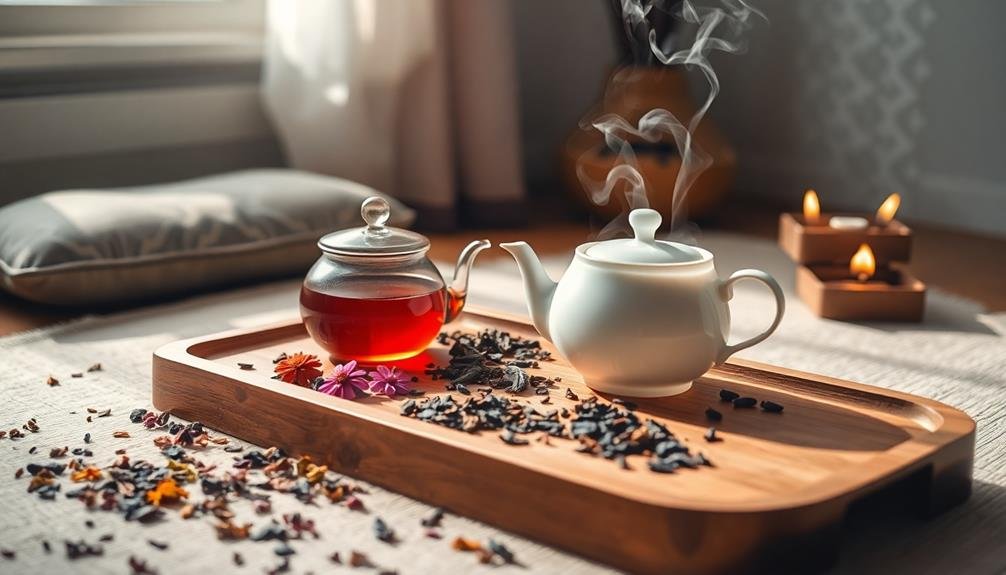
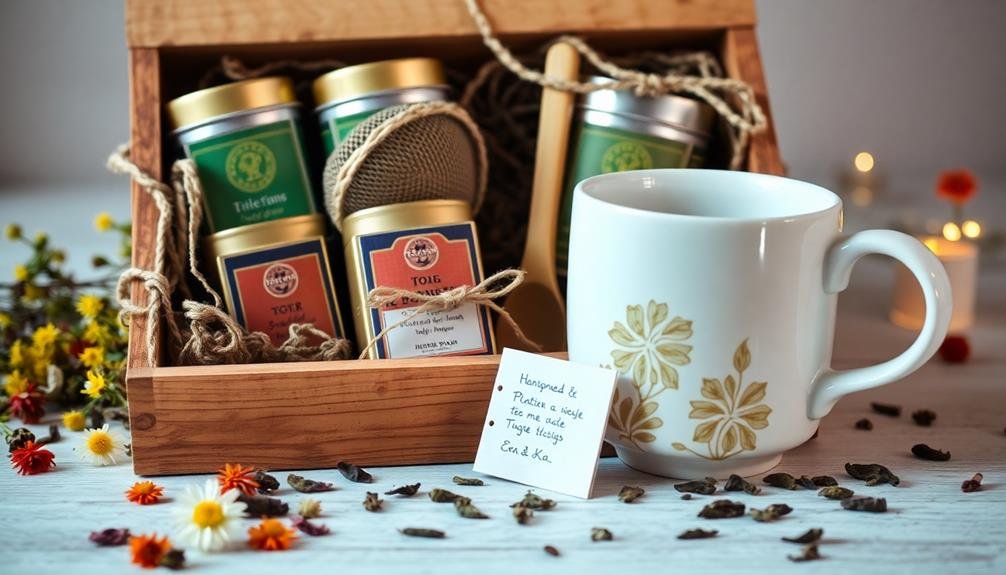
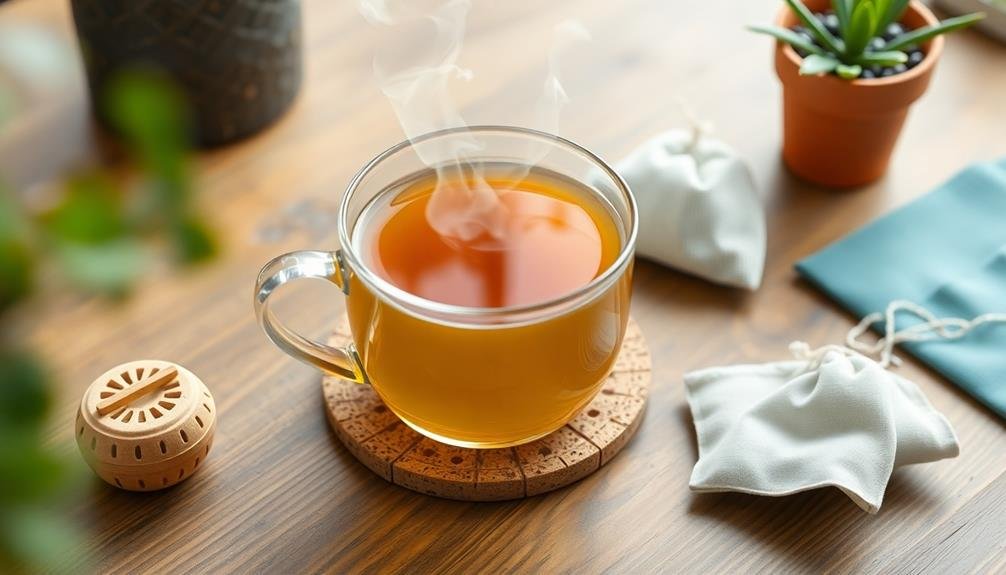
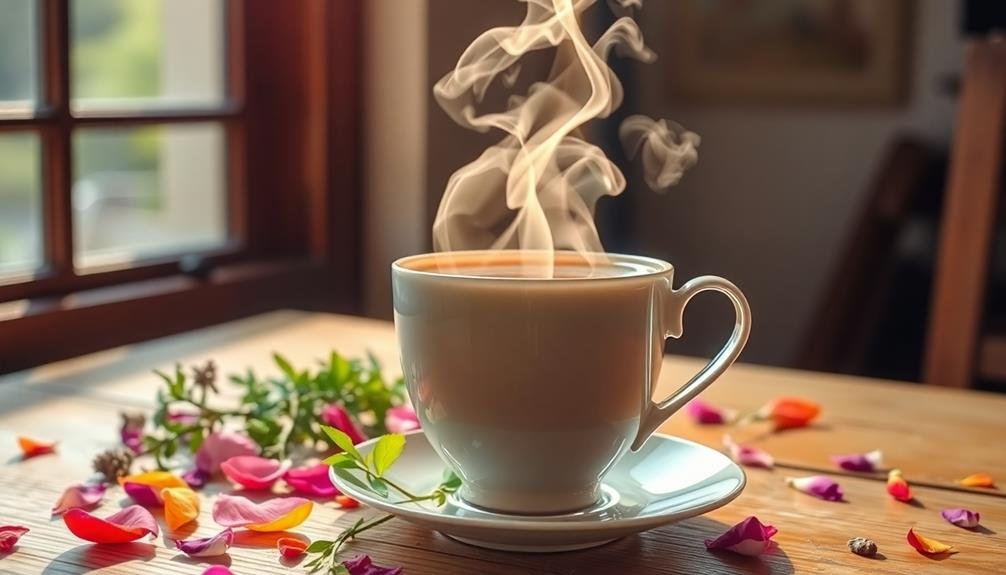
Leave a Reply